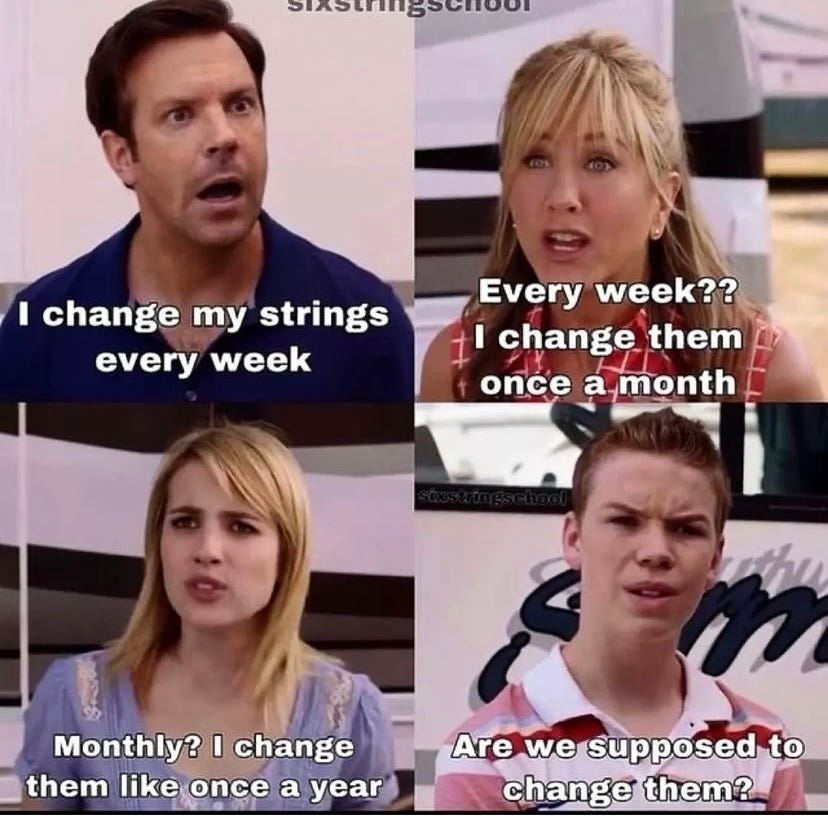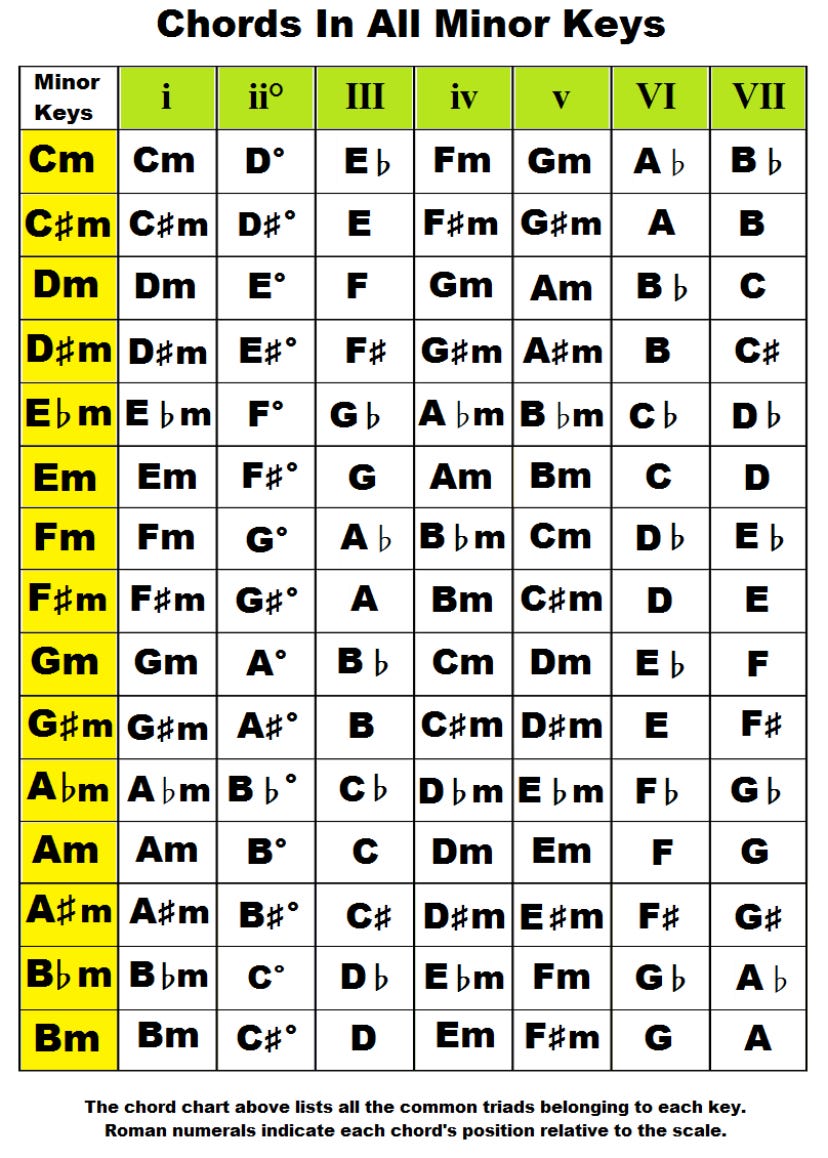Maintenance And "The Other Keys"
A girl who wants to have fun, acoustically
Last week’s Bonus Round answer is a song by Richard Thompson, “1952 Vincent Black Lightning”
"1952 Vincent Black Lightning" is a song by guitarist Richard Thompson from his 1991 album Rumor and Sigh. It tells the story of a thief named James and the girl Red Molly whom he charms with a ride on his 1952 Vincent Black Lightning motorcycle. In 2011 Timemagazine listed the song in its "All TIME 100 Songs", a list of "the most extraordinary English-language popular recordings since the beginning of TIME magazine in 1923," praising it as "a glorious example of what one guy can accomplish with just a guitar, a voice, an imagination and a set of astonishingly nimble fingers."[1] Credit: Wikipedia
A slight correcting of the record: Last week’s Michael Acoustic contained this paragraph:
“Brad (Kyle - a fellow SubStacker) helpfully gave me some insider tips on “DJ lingo” - such as that “gap between tracks” is known in DJ jargon as the “5 second band”, and promo albums without those gaps were often sent out to radio stations - the resulting songs were called “recorded segues”.”
Brad asked me to convey the “5 second band” phrase was illustrative only - it’s just the “band” - the 5 seconds was his own example. The promo records were sent out differently than I described, but I’m kind of a loss as to how, so I’ll just say “strike that from the record”. Maybe Brad will do a “primer” on inside radio talk/lingo some day - stuff like that fascinates me. Also the phrase “recorded segue” was more of his own term than an industry term. Having corrected that, I like the term “recorded segue” so much I’m usig it from now on to describe songs that sort of naturally slide together musically, and IMHO, shouldn’t have much of a “band” between them at all, like the Heart song “Dreamboat Annie (Fantasy Child)” just glides right into “Crazy On You”.
So, a curious thing came up the other day - it’s been really hot here in the upper left corner and I’ve been learning barre chords (or sort of a valiant attempt, though I’ve seen just enough progress to stick with it - this week it’s “Hotel California”, but using only barre chords - we’ll see).
What do those two seemingly unrelated occurrences have to do with another? I was using an electric guitar (a Fender Stratocaster) to practice barre chords since the strings are lighter and the amped sound can cover a greater number of playing sins than an acoustic. I was having a hard time and noticed the action in the Strat seemed high - unusually high -and as I was playing down the fretboard towards the pickups it felt like my thumb was about to seize up (that may or may not be the term medical professionals use for it, but it conveys the feeling accurately). That’s not unusual for beginning barre chord practice (apparently, at least according to my guitar instructor, the subtext there being “suck it up, buttercup!”), but it prompted me to switch to an older Gibson Les Paul I’d acquired a few years ago with a more normal looking action height. Instant relief! (at least some, anyway). My guitar lessons are in a small room at the locally owned guitar shop where I take all my guitars for maintenance and I mentioned it to Nate, the owner. Yep, heat and low humidity can cause guitar necks to “relax”, raising the action a bit. If you’re relatively new to guitars, the “action” of a guitar is defined by how close the strings sit relative to the fretboard - closer is a “low action” (desirable - less pressure needed to engage your fretting hand and quicker release, enabling faster chord changes), “high actions” mean there is more space between the stings and fretboard - requiring more pressure and resulting in more fret noise (dead strings/fret buzz on the release) during chord changes.
So the Strat’s going in for a setup and new strings and I’ll be evaluating the other guitars as well, probably time for a setup and new strings for some at least.
yeah…..
Changing strings is a bit time consuming, but relatively easy:
Yep, they’re gonna pitch some Martin products, but this is definitely the way to do it.
Anything past a string change I leave to the pros, but your mileage may vary.
For you DIY folks, here ya go:
Acoustic Guitar Magazine - some guitar maintenance links
Before you get in too much trouble, though (for me that’s the point where i start using VERYBADWORDS), some consultation with the pros at your locally owned guitar might pay off in the long run.
Now for something completely different: We haven’t talked a lot about minor keys, especially the relative minor keys that use the same chords as their relative Major keys, just with a different starting point. Writing in a minor key can be a little challenging, but if your lyrics are moody or a little sad and you’re looking to convey that feeling, writing in a relative minor key can help set a darker mood. There are lots of charts that show the chord structure in the relative minor keys. There are also several “types” of minor keys, relative minors being but one of them - and that’s a little deep in the music theory weeds, so we’re gonna just stick with relative minors - and lightly at that - for now.
Remember this?
The Circle Of Fifths
The outer ring has the names of each of the Major keys used in Western (as in historically European based music, not so much Country And….) music, the inner shaded ring is composed of the names of the relative minor keys that correspond to the Major keys in the outer ring.
Here’s a chart of chords in each relative minor key:
Look down the left side to the “Am” line. Note on the Circle of Fifths chart above - Am (inner ring) is the relative minor of the key of CMaj (top of the chart, outer ring). The relative minor uses the same chords as the Major, it just starts on the vi - (the 6 minor) and goes from there. So what? you might say. If you sort of think in the minor chords of the key, and use them as your writing anchors more than the Major chord progressions we’re used to, the musical feeling conveyed will be more in the sad, darker mood. This article may help, though it’s a bit into the music theory swamp as well:
So probably enough to think about for this week!!
Bonus Round: How many times, if it’s live? This is probably way too easy - I’m thinking of a specific performance in a specific city….
Cheers, and keep playing!!
Michael Acoustic






Where can I find an accurate transcription of Second Avenue by Tim Moore? The available ones oversimplify the piano harmony. For example, the "B" chord listed in one chart is in reality D/B. Gagliardigregg@gmail.com